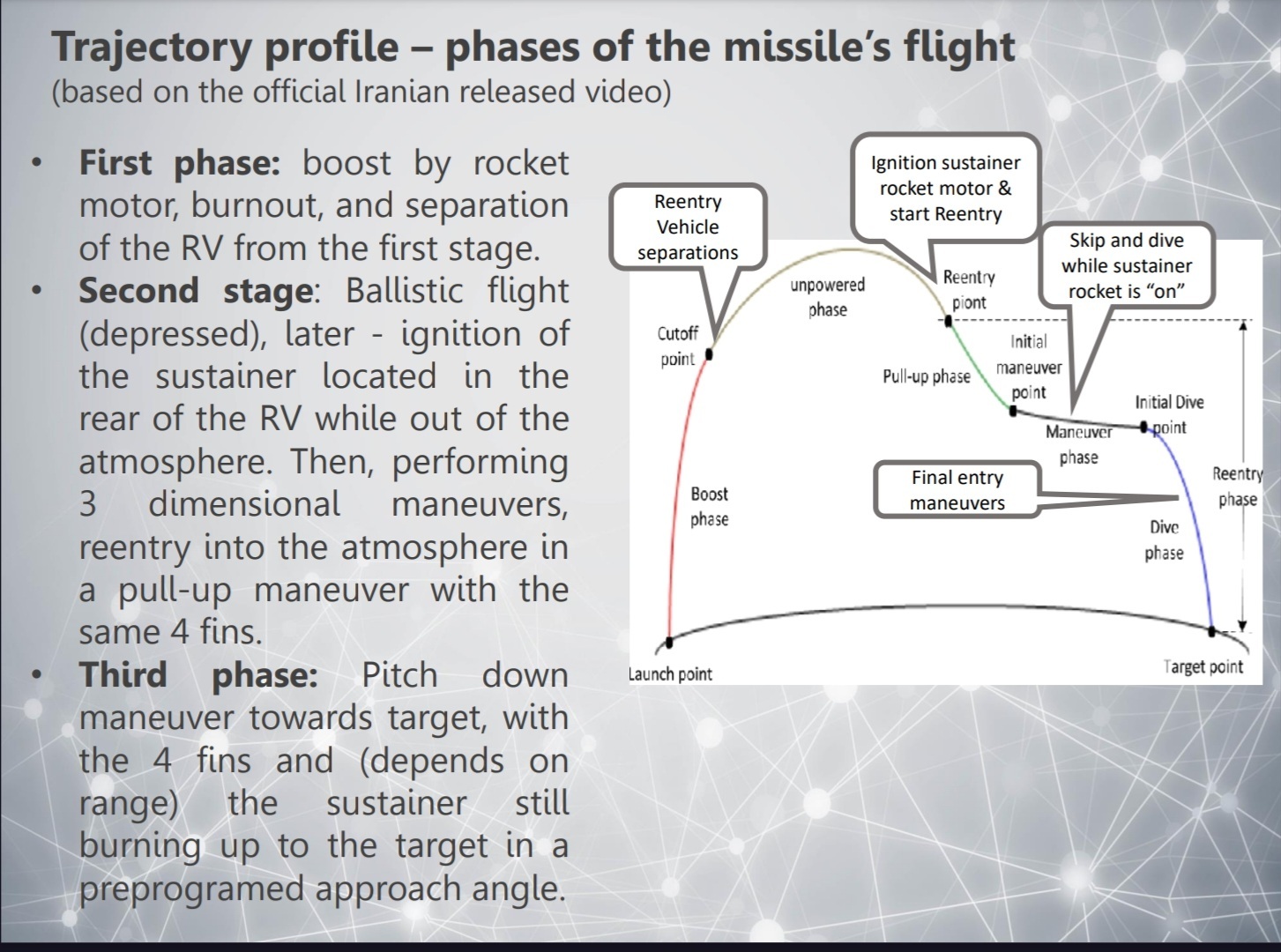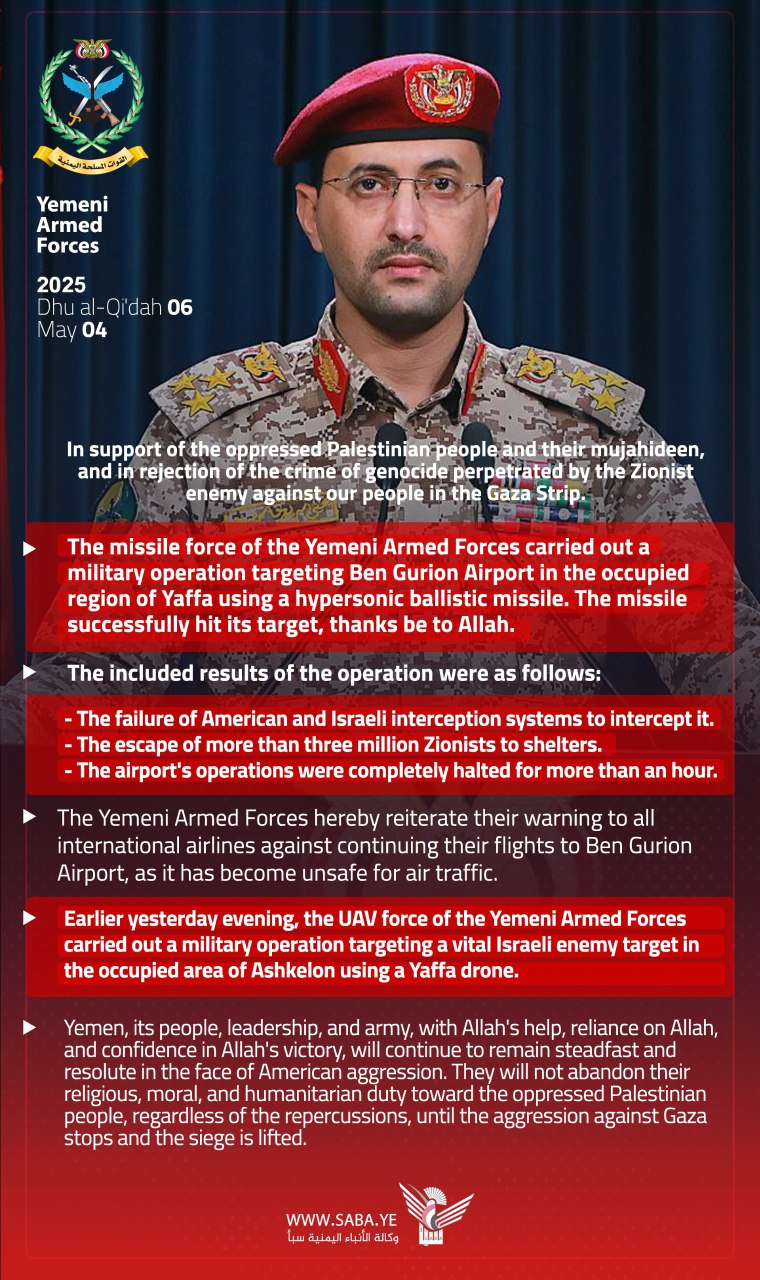Good. Now shut down the rest of them.
MarmiteLover123
There was someone in another thread on Lemmy ml that worked for Wizz air or knew people that worked for them according to their comments, so I wonder what they think of this news.
No change in the type of missile, a Palestine-2 (Fattah-1/Kheibar Shekan variant). Overall in capabilities they're getting better at evading midcourse interception since the beginning of the campaign, meaning Israel has to use terminal phase interceptors like Arrow-2 or THAAD. Overall 27 ballistic missiles of various types (some maneuverable, some not) have been launched at Israel since March 15, with 25 being partially or fully intercepted, and two direct hits. (92.5% interception rate, 7.5% hit rate). So you could say it's a lucky hit, or an inevitable one given that 100% interception is impossible. The caveat here is that only one or two missiles are fired at a time by Yemen, if advanced missiles (like Palestine-2/Fattah-1/Kheibar Shekan) get fired in a sufficient volley, the hit rate would be substantially higher, even with THAAD in the picture.
Yemen is basically showing that even a small nation being bombed like they are can still inflict massive damage to the Americans, and their empire, which includes the zionist entity
Yes, but with the support of a large regional military power/state actor with advanced military technology that they are prepared to let you use and locally manufacture (in Iran), and being able to accept the consequences of carrying out military action (over 1000 airstikes since March 15). Most small nations don't have that.
This could be the second retired Israeli Patriot PAC-2 battery being sent to Ukraine, one was already planned to be sent earlier this year, or it could be about refurbishing that already planned battery. Interesting that the deal was made under Biden, I thought this was a Trump idea at first.
I don't think more Patriot PAC-2s will help against Russian ballistic missiles, the altitude ceiling for ballistic targets on the PAC 2 is 20km, Iskander M ballistic missiles can reach altitudes as high as 50km. Ukraine would need more Patriot PAC-3 MSE batteries for a more realistic chance of interception, or to get one of their rare Soviet era S-300V batteries operational, if they have any left. The loss of an S-300V battery at Sumy was very costly, there are no replacements for this that Ukraine can source.
Not really, the Israeli full statement also says that the Israeli Arrow 2 and 3 systems also failed to intercept.
Both the Israeli Air Force’s long-range Arrow air defense system and the American THAAD system failed to intercept the Houthi missile this morning, defense sources say.
The IDF says it made several attempts to down the missile, which ultimately landed within the perimeter of Ben Gurion Airport.
To understand what happened, we have to understand how the layered air defence shield works. There's Israeli Arrow 3 and optionally US Navy SM-3 for midcourse interception, then Israeli Arrow 2 and THAAD for terminal phase intercepts (and David's Sling if the missile is fired at a military site). No Iron Dome, it's not designed to intercept ballistic missiles.
Here's an exaggerated not to scale graphic showing the phases of flight of a MaRV equipped ballistic missile, the captions are based on the flight behaviour of the Iranian Fattah-1 missile:

The first chance to intercept after the launch of the missile is detected by US Space Force early warning satellites, is early in the midcourse/unpowered flight phase, or even late in the boost phase with a US Navy SM-3, if a US Navy warship is close enough to Yemen and has an SM-3 to spare. That was not the case according to reports, no mention of SM-3. Then the next chance to intercept is with an Arrow-3 in the midcourse, the missile evidently evaded midcourse interception, the Palestine-2 and Fattah-1 missiles can do that better than others.
Then there's the terminal intercept systems in Arrow 2 and THAAD (Terminal High Altitude Air Defense). The reason THAAD was brought in was to plug a defensive gap in the Arrow-2 system, which has a maximum altitude ceiling of 50km. Thus, a Maneuverable Re-entry Vehicle (MaRV) capable ballistic missile could glide above that ceiling, before diving straight down towards the target at a steep angle, giving Arrow 2 a very short time to engage (around 36 seconds to illuminate, fire and intercept if the average speed of the Marv is 4200kph, Arrow-2 can engage targets at altitudes between 8-50km). THAAD plugs this gap as it's maximum altitude ceiling is 150km, so MaRVs can't glide above that (hence terminal high altitude air defence acronym). THAAD can't engage targets at lower altitudes though, it's minimum altitude floor is 40km, meaning that THAAD on its own could be defeated by MaRVs gliding under this floor. Thus THAAD is designed to be used in conjunction with systems like Arrow-2 or Patriot which cover those lower altitudes, they compliment each other as a layered terminal air defence net. To make interception as difficult as possible, a MaRV could glide say at an altitude between 40-50km before diving down to the target, at the edge of both THAAD and Arrow-2s floor and ceiling respectively. So I'd guess what happened was something like that, and both THAAD and Arrow-2 fired interceptors and both missed this time.
Graphic showing THAAD engagement envelope, with a hypothetical Iranian Dezful MaRV trajectory plan to glide under the engagement envelope:

Swear I thought that SLS died years ago. How the hell was it still around?
US and UK airstrikes continue on Yemen for the 51st night in a row. The following governorates were hit by airstrikes:
Hodeidah:
- Unspecified amount of airstrikes hit Ras Isa Fuel Port.
Sana'a:
- Fighter jets heard over Sana'a.
- 3 airstrikes hit the Sawad area in the Sanhan district.
- Unspecified amount of airstrikes hit Al-Malikah area in Bani Hushaysh.
- 6 airstrikes hit the Bani Matar District.
- 2 airstrikes hit the Sa'wan area of Shu'ub District.
- Unspecified amount of airstrikes hit Al Rawdah area of Bani Al Harith District, near the airport.
- 2 airstrikes hit the Attan area of Bani Matar District.
Ma'rib:
- 2 airstrikes on Raghwan district.
Al-Jawf:
- 3 airstrikes hit the Khabb wa ash Sha'af District.
Big focus on Sana'a today, after it was excluded from strikes yesterday.
Warning for potential graphic imagery during ongoing airstrikes:
I hope to get my post about the Franken SAMs out tomorrow, but who knows, maybe Iran will unveil another ballistic missile, or Yemen will hit another target, and delay it further.
Latest statement by the Yemeni Armed Forces on the ballistic missile strike at Ben Gurion airport, and the announcement of a air blockade on Israel, something that they've been working on since March 22nd. I think the direct hit very near the airport terminal and control tower has given Yahya Sare'e the necessary political capital and confidence to announce it more broadly now.


Difference is Israel has nuclear warheads and ICBMs, and Iran does not. But good point on the ambiguity doctrine, that's very true.
Because if Iran takes further steps to develop a nuclear weapon, it in effect acts as an open invitation for the USA to bomb Iran. Iran does not want that. So by leaving nuclear weapons as an issue open to negotiation, Iran hopes to extract some concessions (sanctions relief, aspects like the ballistic missile programme not being a part of the deal) using the bargaining chips of increased uranium enrichment and more missiles to extract these concessions.
This isn't the first time they've tried to do this. Brigadier General Yahya Sare'e said Israeli airports were an "unsafe area" when they first targeted them over a month ago, but back then the missiles were intercepted. It's just with the missile not being intercepted this time, and impacting around 500m away from the control tower and main terminal, they have the political capital to make a public announcement like this. The Yemeni Armed Forces have been trying to carry out an air blockade against Israel for some time, since March 22nd 2025 at least.
Joint Israeli - US airstrikes currently taking place on Yemen, airstikes continue for the 52nd day and night in a row.
Daytime airstrikes by the US hit the following governorates:
Al Jawf:
Sana'a:
Nighttime airstrikes by Israel hit the following governorates, Israeli media says 30 aircraft were involved and over 50 munitions were used:
Hodeidah:
Nighttime airstrikes by the US Navy and Air Force hit the following governorates:
Sana'a:
Warning for potential graphic imagery during ongoing airstrikes:
Al Masirah TV twitter
Xcancel mirror
The IOF/IDF has released images of the planes that participated in the operation. An Israeli F-15I is seen carrying 5 2000lb GBU-31 JDAM stand in GPS guided bombs, along with conformal and external fuel tanks. 10 of these planes = 50 bombs. The rest of the Israeli aircraft would have been support assets like mid air refueling aircraft, AWACS aircraft, and reconnaissance aircraft/drones. The use of stand in weapons like JDAMs for this attack is notable, as previous Israeli strikes on Yemen, such as those in December last year, used stand off munitions, including the Rampage air launched guided artillery rocket. Like the British a few days ago, the Israelis have taken advantage of the corridors the US Navy has opened in Yemen to carry out stand in strikes.
The corridors get opened by the EA-18G Growler Electronic Warfare and Suppression/Destruction of Enemy Air Defenses aircraft (SEAD/DEAD). This is a picture of an EA-18G on the USS Harry Truman yesterday, May 4, in the standard heavy SEAD/DEAD loadout against for this conflict: 4 AGM-88E AARGM anti radiation missiles, 2 AIM-120 AMRAAM air to air missiles for taking out drones and air to air loitering munitions, and 3 480 Gal fuel tanks for increased range and loiter time over the battle space:
The EA-18G is an extremely important capability. Anyone going into conventional military conflict with the United States will need to counter it and/or develop their own analogue to it.